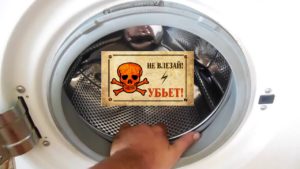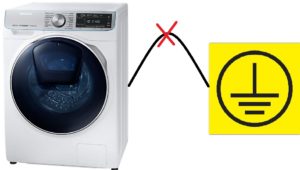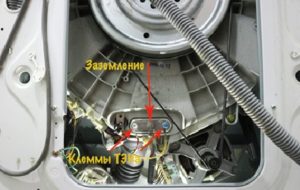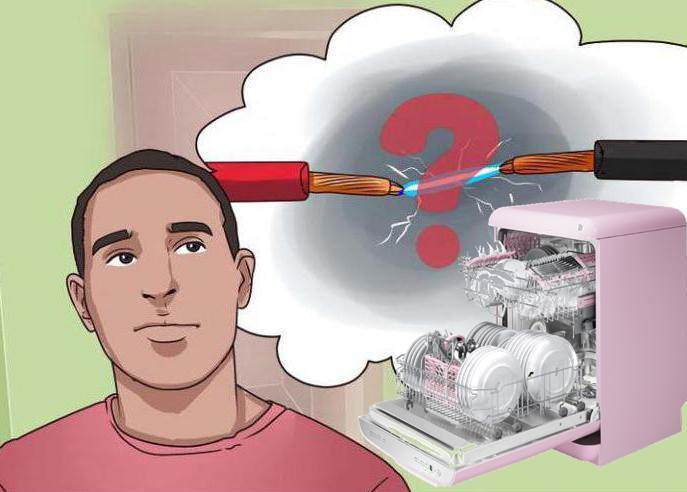Why is the washing machine drum electrocuted?
 It is necessary to operate household appliances in compliance with basic safety rules. Devices connected to the network can shock the user, and such a shock is extremely unpleasant and very dangerous for humans. If the drum of the washing machine shocks even at the slightest touch to it, you need to urgently eliminate this problem. Let’s figure out why an automatic washing machine can “tingle” the housewives’ fingers, how to find a way out of this situation and prevent breakdowns of the washing machine’s current.
It is necessary to operate household appliances in compliance with basic safety rules. Devices connected to the network can shock the user, and such a shock is extremely unpleasant and very dangerous for humans. If the drum of the washing machine shocks even at the slightest touch to it, you need to urgently eliminate this problem. Let’s figure out why an automatic washing machine can “tingle” the housewives’ fingers, how to find a way out of this situation and prevent breakdowns of the washing machine’s current.
No connection to ground
Even the most modern household appliances are manufactured taking into account the fact that a small amount of electrical flow will be transmitted through the body of the device to the general house grounding system. The first and most common reason why an automatic washing machine shocks a person is the lack of grounding of the home electrical network. When the grounding is not connected, a small charge will accumulate on the walls of the washing machine, and this is what the owner will feel when she touches the machine. Electric shocks will be felt more strongly when you touch the drum with wet hands.
This problem can be solved by grounding the electrical wiring in the home. Typically, electrical panels of high-rise buildings contain grounding terminals. However, some Khrushchev buildings may not have them, then you will have to ground the washing machine directly. There is another way to cope with the problem; we will discuss the second method further.
If the machine is installed in the kitchen, in the hallway or in the corridor, that is, in rooms with little humidity, the electric shock may not be felt at all.But when the washing machine is in the bathroom, it will not be possible to avoid the “tingling” of your hands; the transfer of the current charge to the body will be felt quite accurately.
Damage to the wiring or breakdown of the heating element
If the ground is connected, most likely the washing machine is receiving a strong current due to some internal failure that has occurred in the system. Very often, charge accumulation on the housing occurs due to damage to the wiring inside the unit or failure of the heating element.
To diagnose the internal parts, it is necessary to disconnect the rear wall of the case, after first unscrewing the bolts holding it. After removing the cover, inspect the wiring of the machine for defects, kinks, or damage. If you don’t find anything suspicious, proceed to checking the heating element.
The heater of different models of washing machines is located in completely polar places. On appliances of the brands Ariston, Samsung, Indesit - on the back, in Bosch, AEG, Siemens washing machines - on the front.
To simplify the process of finding a heating element, we recommend that you find the element’s connection diagram in the user manual.
 To check if the heater is working properly, you will need a multimeter. Disconnect the wires from the heating element, set the tester to the resistance determination mode, set the selector of the measuring device to 200 Ohms, attach the multimeter probes to the contacts of the heating element. If the tester screen displays a value from 20 to 30 Ohms, we can conclude that the heating element is working. A value of 1 or 0 will indicate its malfunction. One will indicate an open circuit inside the element, zero will indicate a short circuit of the heater.
To check if the heater is working properly, you will need a multimeter. Disconnect the wires from the heating element, set the tester to the resistance determination mode, set the selector of the measuring device to 200 Ohms, attach the multimeter probes to the contacts of the heating element. If the tester screen displays a value from 20 to 30 Ohms, we can conclude that the heating element is working. A value of 1 or 0 will indicate its malfunction. One will indicate an open circuit inside the element, zero will indicate a short circuit of the heater.
After carrying out manipulations to check the serviceability of the part, it is necessary to test it for breakdown. After all, even the ideal resistance value shown by a multimeter does not mean that the current from the heating element does not pass to the body of the washing machine. There is a dielectric between the tubes and the walls of the heater, which can leak into the system.
You can also check the heating element for breakdown using a tester. Having selected the buzzer operating mode, attach one multimeter probe to the heating element terminal, and lean the second probe against its body. If the device does not make any sounds, the heater is working; if the tester starts beeping, a breakdown has occurred. The heating element is not repaired; a new, functioning part is simply installed in place of the old heating element.
If there is no breakdown, but there is a breakdown?
To maximally prevent the possibility of electric shock when using a washing machine, additional manipulations should be performed with the house electrical network. You can protect yourself using the following methods:
- Connect to the network a residual current device with a rated load current in the protection zone from 10 to 30 mA. The RCD will trip even with the smallest current leakage, turning off the power to the device at the electrical panel. If the wiring in the apartment is old, two-wire, instead of modern three-wire, installing the device may cause some inconvenience. The machine will click often without much need, and you will have to regularly turn on the power at the electrical panel.
- Create a system for balancing the potentials of household appliances.
- Make sure the integrity of the “ground”. In certain cases, the washing machine receives electric shock even when the ground is connected.This may be caused by a damaged ground wire. It is worth finding where the break occurs, checking the conductor and restoring it.
If you feel a “tingling” sensation in your fingers when touching the faucet in the bathroom, you need to quickly turn off the electricity in the room and find the wiring fault.
It is strictly forbidden to understand why an automatic machine is electrocuted at high voltage.
Wrong methods to solve the problem
If you decide to deal with the problem yourself, you need to understand what actions are not advisable to take. When “studying” forums, along with competent advice, you can come across incorrect recommendations from “would-be masters”. So, do not take into account and use the following troubleshooting methods:
- If there is no grounding, you can simply insert the plug into the socket, turning the plug over, and also cover the floors in your visit with a rubber mat. This method, of course, can stop single impacts, but it will not solve the problem. Ultimately, the user may still be electrocuted.
- Stop the washing machine's surge protector. This element is designed specifically to redirect the electrical charge to the body of the machine. Common people believe that turning it off will completely protect against electric shock when touching equipment. This opinion is wrong; the risk will decrease only slightly.
- Connect the grounding conductor from the automatic machine to a pipe or radiator. Such actions are very dangerous and can result in severe electric shock. Experts categorically do not recommend using this method.
- Remove the isolated PE cable from the panel.Remember, you cannot install a separate grounding conductor and plug the equipment into an outlet without a ground. The correct solution would be to remove the three-wire wire from the distributor and connect a special, safe socket to the cable.
By finding out the reason why the washing machine drum periodically shocks you, you can eliminate such a dangerous nuisance. It is important to carry out repairs consciously, observing all safety regulations.
Interesting:
Reader comments
- Share your opinion - leave a comment
Categories
Washing machine repair


For buyers

For users

Dishwasher

















Add a comment